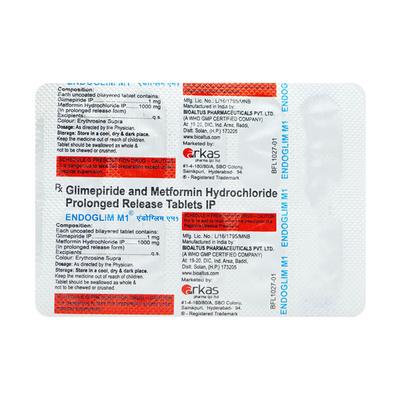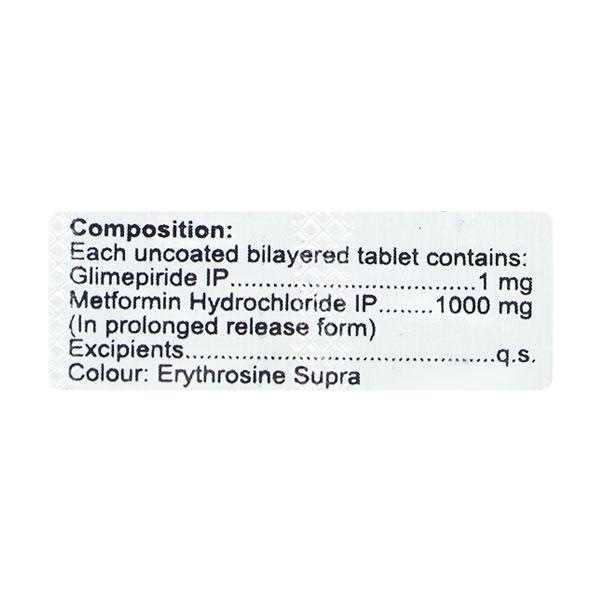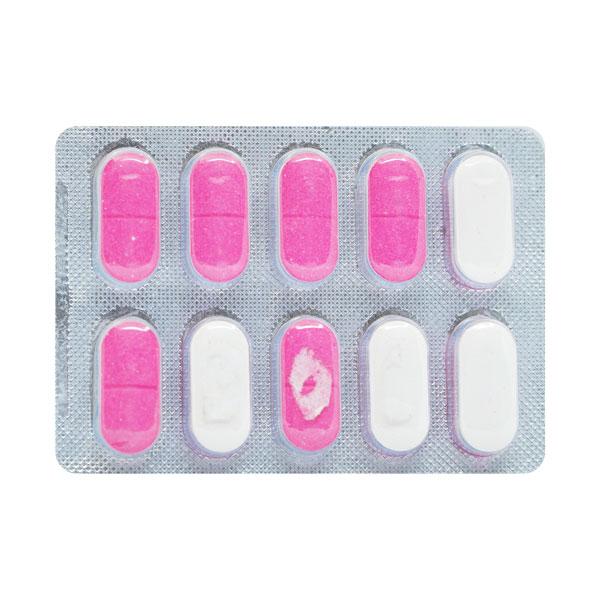

Netmeds First Membership
Quick Links
Introduction About ENDOGLIM M 1MG TABLET
ENDOGLIM M 1MG TABLET is used to manage type 2 diabetes mellitus when diet, exercise and the single agent does not result in adequate glycemic control. It is a combination of Glimepiride and Metformin which belongs to a group of medicines called Antidiabetic agents. Glimepiride lowers blood sugar by causing the pancreas to produce more insulin and helps the body to use insulin efficiently. Metformin reduces the total amount of sugar released into the blood by the liver.
Along management with ENDOGLIM M 1MG TABLET follow regular exercise and diet plan as advised by your doctor to achieve better results. Before taking ENDOGLIM M 1MG TABLET inform your doctor if you have type 1 diabetes mellitus, diabetic ketoacidosis, severe liver or kidney disease, acute heart problems. Inform your doctor if you are pregnant or breastfeeding. It is not suitable for use in children and adolescents under 18 years of age.
Avoid consumption of alcohol during management with ENDOGLIM M 1MG TABLET as it may increase or decrease the blood sugar lowering action of ENDOGLIM M 1MG TABLET and increases the risk of lactic acidosis. The most common side effects of taking ENDOGLIM M 1MG TABLET are taste disturbance, diarrhea or stomach ache. Contact your doctor if any of the symptoms worsen.
Uses Of ENDOGLIM M 1MG TABLET
- Used to manage type 2 diabetes mellitus (when diet, exercise and the single agent does not result in adequate glycemic control)
How ENDOGLIM M 1MG TABLET Works
ENDOGLIM M 1MG TABLET controls blood glucose levels, where Glimepiride works by increasing the amount of insulin released by the pancreas in order to lower the blood glucose. Metformin works by lowering glucose production in the liver, delaying glucose absorption from intestine, and increasing the body's sensitivity to insulin.
How to use ENDOGLIM M 1MG TABLET
- Take ENDOGLIM M 1MG TABLET as advised by your physician
- Swallow ENDOGLIM M 1MG TABLET with a glass of water. Do not crush or chew the medicine
- Your doctor will decide the correct dose and duration for you depending upon your age, body weight and disease condition
- Do not stop taking ENDOGLIM M 1MG TABLET without informing your doctor.
Side Effects Of ENDOGLIM M 1MG TABLET
Common side effects of ENDOGLIM M 1MG TABLET:
- taste disturbance
- diarrhea
- stomach pain
- loss of appetite
Stop taking ENDOGLIM M 1MG TABLET and contact your doctor immediately if you experience any of the following side effects:
- lactic acidosis
- inflammation of the liver which may result in jaundice (yellowing of skin or eyes)
- severe allergic reactions (such as skin rash, hives, and increased sensitivity to sun, inflammation of blood vessels which may develop into serious reactions with difficulty in breathing, fall in blood pressure and sometimes progressing to shock)
- severe low blood sugar levels
Warning & Precautions
Pregnancy
ContraindicatedENDOGLIM M 1MG TABLET should not be taken during pregnancy. Consult your doctor before taking ENDOGLIM M 1MG TABLET if you are planning to become pregnant.
Breastfeeding
ContraindicatedENDOGLIM M 1MG TABLET should not be taken during breastfeeding as it may pass through breast milk.
Driving and Using Machines
Use with CautionDo not drive or handle any machines if you experience low or high blood sugar levels (symptoms include dizziness, tiredness, shaking or trembling) or if you develop visual problems due to altered blood sugar levels.
Alcohol
Consult your doctorAvoid consumption of alcohol during management with ENDOGLIM M 1MG TABLET as it may increase or decrease the blood sugar lowering action of ENDOGLIM M 1MG TABLET and increases the risk of lactic acidosis.
Kidney
Consult your doctorENDOGLIM M 1MG TABLET is not recommended for use in patients with severe kidney disease and it should be used with caution in patients with kidney disease and your dose will be adjusted if needed depending upon kidney function.
Liver
Consult your doctorENDOGLIM M 1MG TABLET is not recommended if you have severe liver disease and it should be used with caution in patients with liver disease and your dose will be adjusted if needed depending upon liver function.
Allergy
ContraindicatedDo not take ENDOGLIM M 1MG TABLET if you are allergic (hypersensitive) to Glimepiride or Metformin or other sulfonylureas (such as glipizide, glibenclamide) or sulfonamides (such as sulfamethoxazole).
Heart Disease
ContraindicatedENDOGLIM M 1MG TABLET is not recommended for use in patients with acute heart problems or recently had a heart attack or have severe circulatory problems or breathing difficulties (signs of heart failure).
Use In Pediatrics
ContraindicatedENDOGLIM M 1MG TABLET is not recommended for use in children and adolescents (under 18 years of age).
Use In Geriatrics
Consult your doctorENDOGLIM M 1MG TABLET is not recommended for use in elderly patients (aged 75 years or above) and it should be used with caution in elderly patients (aged 65 years or above), especially in patients with impaired kidney function. Your doctor may assess your kidney function more frequently during management with ENDOGLIM M 1MG TABLET.
Others
ENDOGLIM M 1MG TABLET is not recommended for use, if you have:
- type 1 diabetes mellitus
- diabetic ketoacidosis
- uncontrolled diabetes or ketoacidosis
- dehydration
- severe infection
Before taking ENDOGLIM M 1MG TABLET inform your doctor if you:
- are recovering from injury, operation, infections with fever, or from other forms of stress
- have glucose-6-phosphate dehydrogenase (G6PD) deficiency
- have various factors which could increase the risk of low blood sugar levels (such as undernourishment, irregular mealtime, missed or delayed meal or period of fasting, change in diet, hormone-induced disorders)
Interactions
A. Drug-Drug interactions:
Before taking ENDOGLIM M 1MG TABLET inform to your doctor, if you are taking any of these medicines:
- Sulphonylureas (Ex. glibenclamide, insulin)
- Anabolics
- Anticoagulants (Ex. Warfarin)
- Anticonvulsants (Ex. Fenfluramine, Phenytoin)
- NSAIDs (Ex. Phenylbutazone, azopropazone, oxyphenbutazone)
- Class 1a anti-arrhythmic agent (Ex. Disopyramide)
- Fibrates (Ex. fenofibrate, nicotinic acid, colesevelam)
- Angiotensin-converting enzyme (Ex. captopril, lisinopril)
- Diuretics (Ex. furosemide, chlorthalidone, hydrochlorothiazide or diazoxide)
- Monoamine oxidase inhibitors (Ex. isocarboxazid, selegiline and chlorpromazine)
- Antigout agents (Ex. Allopurinol, probenecid, sulfinpyrazone)
- Alkylating agents (Ex. Cyclophosphamide, ifosfamide, trofosfamide)
- Tetracyclines (Ex. minocycline, doxycycline, chloramphenicol, fluconazole, miconazole
- Quinolones (Ex. moxifloxacin, ciprofloxacin, clarithromycin, rifampicin
- Tritoqualine, glucocorticoids (Ex. beclomethasone, hydrocortisone)
- Hemorrheologic agents (Ex. Pentoxifylline)
- Sulfonamides (Ex. sulfamethoxazole)
- Androstane class (Ex. testosterone)
- Natural or synthetic (Ex. oestrogens, progestogens)
- Sympatholytics (Ex. clonidine, methyldopa)
- Hormones (Ex. Levothyroxine)
- Adrenaline and sympathomimetics (Ex. phenylephrine, norepinephrine)
- Laxatives (Ex. bisacodyl)
- Antidiabetics (Ex. Glucagon)
- Barbiturates (Ex. pentobarbital, amobarbital)
- Carbonic anhydrase inhibitors (Ex. Acetazolamide)
Overdosage:
If you or anyone else takes too much of ENDOGLIM M 1MG TABLET, contact your doctor immediately or go to a nearest hospital straight away. Overdosage symptoms of ENDOGLIM M 1MG TABLET includes risk of low blood sugar levels. Symptoms of lactic acidosis include vomiting, bellyache with muscle cramps, general feeling of not being well with severe tiredness, reduced body temperature, low heartbeat, and difficulty in breathing.
Synopsis
| Drug | : | Glimepiride, Metformin |
| Pharmacological Category | : | Sulfonylureas, Biguanides |
| Therapeutic Indication | : | Type II diabetes mellitus |
| Dosage Forms | : | Tablet |
More Information
FAQs About ENDOGLIM M 1MG TABLET
Q: What is ENDOGLIM M 1MG TABLET used for?
A: ENDOGLIM M 1MG TABLET is used to manage type 2 diabetes mellitus in adults. This combination helps regulate blood sugar levels effectively in individuals whose blood sugar is not adequately controlled by diet, exercise, or a single diabetes medication. It helps reduce the risk of diabetes-related complications such as heart disease, nerve damage, or kidney issues.
Q: How ENDOGLIM M 1MG TABLET works?
A: ENDOGLIM M 1MG TABLET contains a combination of two medicines namely, glimepiride and metformin. Glimepiride stimulates the pancreas to release more insulin, a hormone that lowers blood sugar levels. It also improves the body’s response to insulin. Metformin decreases the amount of sugar produced by the liver and reduces sugar absorption in the intestines. It also enhances the body’s ability to use insulin more effectively, making it a comprehensive treatment for blood sugar control.
Q: What is the best time to take ENDOGLIM M 1MG TABLET?
A: It is usually recommended to take ENDOGLIM M 1MG TABLET with meals to minimize the risk of gastrointestinal side effects such as nausea or upset stomach. Following your doctor’s instructions regarding the timing is essential, as they might tailor the dose to suit your lifestyle and blood sugar patterns.
Q: How many doses of ENDOGLIM M 1MG TABLET can be taken in a day?
A: The dosage depends on the individual’s medical condition, blood sugar levels, and response to treatment. Typically, it is taken once or twice daily with meals, but the exact dose should be determined by a doctor. Taking more than the prescribed dose can lead to hypoglycemia (low blood sugar), so it’s crucial to stick to the recommended schedule.
Q: Can ENDOGLIM M 1MG TABLET be used during pregnancy?
A: The combination of Glimepiride + Metformin is generally not recommended during pregnancy due to the potential risk of harming the unborn baby. Instead, insulin is preferred for controlling blood sugar levels in pregnant women with diabetes. If you are pregnant or planning to conceive, consult your doctor for a safe treatment plan.
Q: Can ENDOGLIM M 1MG TABLET control blood sugar levels?
A: Yes, this medicine is highly effective in controlling blood sugar levels in people with type 2 diabetes especially when diet, lifestyle changes and treatment with single agents does not yield optimum blood sugar control. However, its effectiveness also depends on maintaining a healthy lifestyle, including regular exercise and a balanced diet. Regular monitoring of blood sugar is essential to ensure the medication works optimally.
Q: Who should not use ENDOGLIM M 1MG TABLET?
A: ENDOGLIM M 1MG TABLET is not suitable for individuals with severe kidney or liver disease, type 1 diabetes or diabetic ketoacidosis, known allergies to glimepiride, metformin, or any other ingredients in the medicine, or a history of lactic acidosis. Therefore, always inform your doctor about any pre-existing conditions or medications you are taking to avoid adverse effects.
Q: What are the common side effects of ENDOGLIM M 1MG TABLET?
A: The most common side effects of ENDOGLIM M 1MG TABLET include nausea, vomiting, diarrhea, stomach pain, dizziness, or low blood sugar (hypoglycemia. Consult your doctor if any of these side effects worsens.
Q: Is ENDOGLIM M 1MG TABLET safe?
A: Yes, ENDOGLIM M 1MG TABLET is generally safe when taken as prescribed. However, regular monitoring of kidney and liver function is necessary, as prolonged use can affect these organs. Additionally, following the recommended dose and schedule minimizes the risk of side effects.
Q: Can ENDOGLIM M 1MG TABLET be taken on an empty stomach or before food?
A: No, it is best taken with food to reduce the risk of stomach upset and hypoglycemia. Food helps slow down the absorption of glimepiride, preventing a sudden drop in blood sugar levels, which can cause dizziness or weakness.
Q: Is ENDOGLIM M 1MG TABLET safe for kidney patients?
A: ENDOGLIM M 1MG TABLET is not suitable for individuals with severe kidney disease, as it can increase the risk of lactic acidosis, a potentially life-threatening condition. Mild to moderate kidney impairment requires dose adjustment and close monitoring. Always consult your doctor before starting or continuing this medication.
Q: How long will it take for ENDOGLIM M 1MG TABLET to control blood sugar levels?
A: ENDOGLIM M 1MG TABLET begins to lower blood sugar within a few hours of taking a dose. However, achieving optimal blood sugar control may take a few weeks, depending on individual response and adherence to the prescribed regimen, diet, and exercise plan.
Q: Can I stop taking ENDOGLIM M 1MG TABLET once my blood sugar is controlled?
A: No, stopping the medication without your doctor’s advice can cause your blood sugar levels to rise again, leading to complications. Diabetes is a chronic condition requiring ongoing management. Your doctor may adjust the dose or switch medications based on your progress, but self-discontinuation is not recommended.
References
1. KD Tripathi MD. Hormones and related drugs. Essentials of medical pharmacology. Seventh edition. New Delhi, May 2013. Page – 274.
2. Rakesh Kumar Sahay, Vinod Mittal, G Raja Gopal, Sunil Kota, Ghanshyam Goyal, Mahesh Abhyankar, Santosh Revenkar. Glimepiride and Metformin Combinations in Diabetes Comorbidities and Complications: Real-World Evidence. September 2020. [Accessed on July 24th, 2021] click here
3. Sanofi. Efficacy and Safety Comparison of Metformin/Glimepiride Combination Versus Each Compound Alone in New Diagnosed Type 2 Diabetes Patients (RECOMMEND). NIH U.S. National Library of Medicine. ClinicalTrials.gov. [Revised in January 2015] [Accessed on July 24th, 2021] click here
4. Torrent pharmaceuticals Ltd. Azulix MF. Metformin Hydrochloride Prolonged Release and Glimepiride Tablets I.P. [Revised in July 2019] [Accessed on July 24th, 2021] click here
5. Sanofi-aventis group. Amaryl M. Glimepiride + Metformin. [Revised in May 2015] [Accessed on July 24th 2021] click here










